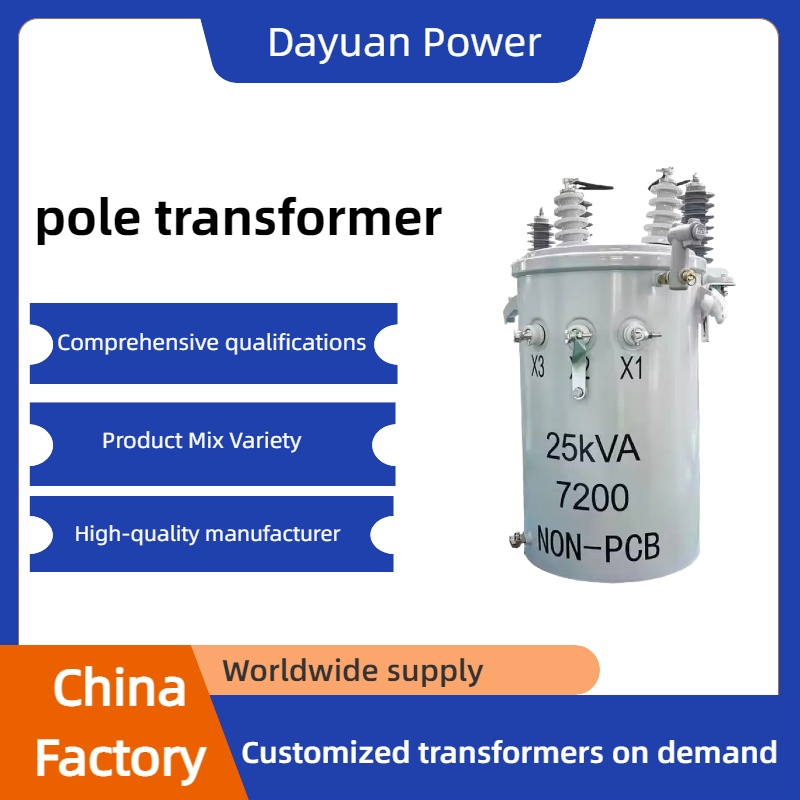2025-06-23
Our company sells pole transformers of various models. Users can customize as per their needs. Our company is a Chinese manufacturer with complete qualifications and various certifications. We provide services in multiple countries. If you need any, please contact us.

1. Core Function: Steps down high-voltage electricity from the primary distribution lines (typically 4,000V to 34,500V or higher) to a much lower, usable voltage (typically 120/240V or 120/208V in North America) for homes, small businesses, and streetlights.
2. Location: Mounted on wooden, concrete, or steel utility poles, usually 15-40 feet above ground.
3. Typical Size (Capacity): Ranges from small (e.g., 5 kVA serving a few homes) to larger units (e.g., 100 kVA serving a small apartment building or cluster of homes). Common sizes are 25 kVA, 37.5 kVA, and 50 kVA.
4. Why "Distribution"?: It's part of the "last step" in getting power from the high-voltage transmission grid to the end consumer.
1.Tank: The main cylindrical or oval metal housing containing the core and windings. Usually painted a distinctive color (e.g., safety green, gray, beige).
2.Cooling Fins/Ribs: Thin metal sheets welded to the tank to increase surface area for better heat dissipation.
3.Fused Cutout: A protective device (often visible as a pivoting fuse holder) on the primary line before it reaches the transformer. It disconnects the transformer if a fault occurs and holds a replaceable fuse.
4.Bushing: Porcelain or polymer insulators where the high-voltage (primary) wires enter and the low-voltage (secondary) wires exit the transformer. Typically 1-3 on top (primary), 1-4 on the side/bottom (secondary).
5.Lightning Arresters: Cylindrical devices mounted near the primary bushings to protect the transformer from voltage surges caused by lightning or switching.
6.Secondary Rack: A platform or bracket below the transformer where the secondary (low-voltage) wires are terminated and connected to the service drops running to customers.
7.Grounding Conductor: A wire running down the pole to a ground rod buried at the base, essential for safety.
8.Nameplate: A metal tag riveted to the tank showing critical specifications (kVA, voltages, impedance, serial number, etc.).
1. High Voltage In: Electricity from the utility's primary distribution lines (e.g., 7,200V) enters the transformer through the primary bushings.
2. Electromagnetic Induction: Inside the tank, the primary winding (coil) creates a changing magnetic field in the laminated steel core.
3. Voltage Step-Down: This changing magnetic field induces a lower voltage in the secondary winding (coil), proportional to the turns ratio between the windings (e.g., 30:1).
4. Low Voltage Out: The reduced voltage (e.g., 240V) exits through the secondary bushings.
5. To Customers: The low-voltage wires leave the transformer via the secondary rack and run along the pole or span directly to customer service entrances via "service drops."
1.Liquid-Filled (Most Common):
Mineral Oil: Traditional, effective coolant/insulator. Requires containment measures due to flammability and environmental concerns.
Less-Flammable Fluids (e.g., FR3, Silicone): Increasingly common for enhanced safety and reduced environmental impact.
2.Dry-Type (Less Common on Poles): Uses solid insulation (epoxy resin, vacuum pressure impregnation - VPI). Lighter, no fluid leaks, but generally lower capacity and less efficient cooling than liquid-filled. Used where fire risk is critical (e.g., inside buildings).
1.Enable Local Power Delivery: Make it feasible and safe to deliver usable power directly to neighborhoods without running extremely high voltages everywhere.
2.Voltage Management: Maintain stable voltage levels for end-use appliances and equipment.
3.Fault Isolation: A fault (like a short circuit) on one transformer's secondary circuit usually doesn't affect customers fed by other transformers on the same primary line.
4.Scalability: Utilities can easily add or replace transformers as local power demand grows or changes.
1.High Voltage Hazard: The primary side carries lethal voltages. Only qualified utility personnel should work on or near them.
2.Maintenance: Utilities perform periodic inspections, oil testing (for liquid-filled), and thermographic scans to check for hot spots.
3.Lifespan: Typically 30-50 years with proper maintenance.
4.Loading: Transformers are rated for a specific capacity (kVA). Overloading causes overheating, reduced lifespan, and potential failure.
5.Humming Sound: The characteristic hum comes from magnetostriction (the core laminations vibrating slightly at the frequency of the AC current - 60Hz in North America)